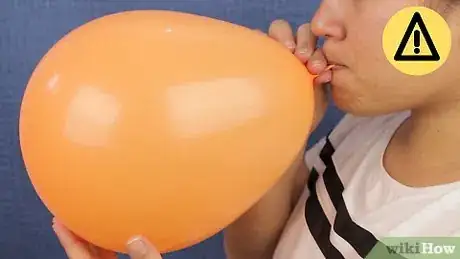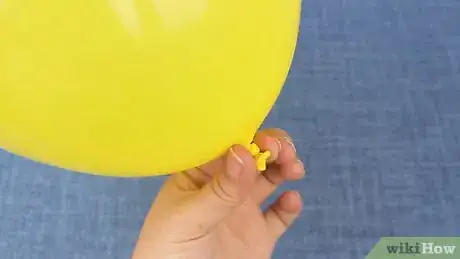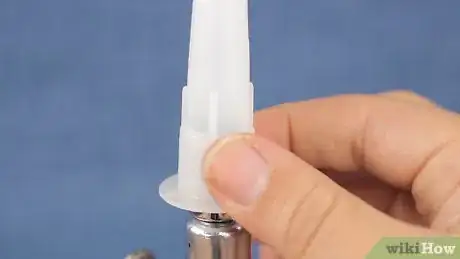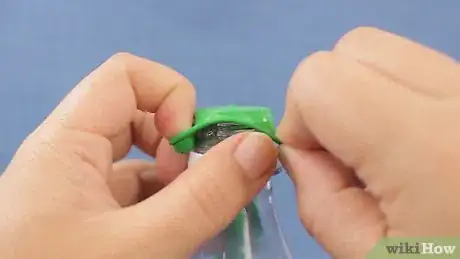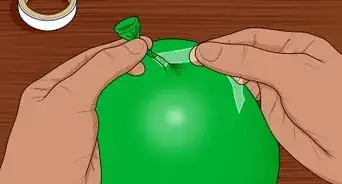This article was co-authored by Ahzahdeh Neshat and by wikiHow staff writer, Christopher M. Osborne, PhD. Ahzahdeh Neshat is a Party Decorating Specialist and the Owner of Confetti & Sprinkles LLC based in Los Angeles, California. With over three years of experience, she specializes in creating extravagant balloon decor for parties and events. Ahzahdeh has created balloon decor for businesses such as MediaLab and Insomnia Cookies.
This article has been viewed 761,512 times.
Balloons are festive additions to birthday parties and many other fun events. Blowing them up isn't always such fun though, as they usually require a good set of lungs or a balloon pump, not to mention some time and patience. Whether you need one balloon or a hundred, or want them for decoration or a science experiment, though, there are several ways to make blowing up a balloon a little easier — and maybe even fun!
Steps
Blowing Up a Balloon by Mouth
-
1Loosen the balloon by stretching it in all directions. If you stretch out the rubbery latex of the balloon with your hands first, it becomes much easier to blow it up by mouth afterwards. Stretching the balloon will loosen the latex, making the inflation process less resistant.[1]
- Stretch the balloon in all directions, being careful not to tear the latex. Just make sure not to stretch the balloon too much, or you risk it popping when you inflate it. A few stretches here and there will get the job done.
-
2Pinch the neck of the balloon with your index finger and thumb. This will keep the balloon in position when inflating. Grasp the end of the balloon about a quarter of an inch (1 cm) below the lip of the opening. Your index finger should be on top and your thumb on bottom.
- If you are blowing a foil balloon, get a straw and stick it into the opening. Then you will gently blow air through the straw.
Advertisement -
3Take a deep breath and “kiss” the balloon. Use your lips to form a seal around the opening neck section of the balloon. Your lips should be just beyond the lip of the balloon opening, and pressed against your thumb and forefinger.
-
4Blow air from your lungs into the balloon. This is the same action used when puffing your cheeks with air, but the air should pass into the balloon and your cheeks should be relaxed.
- Try to keep your lips puckered and tight as you blow into the balloon. Your cheeks will fill with some air, but they shouldn't be getting really big — the balloon should!
- Think of how a trumpeter blows into his or her horn: Maintain good embouchure, or facial muscle tension, especially if your lungs are weak or you're having trouble getting the balloon to fill with air.
- Keep a tight seal between the lip of the balloon and your lips to maintain pressure.
-
5Work to overcome the initial resistance. For reasons that are up to greater scientific debate than you might think,[2] the first blow into a balloon is always the hardest.[3] But it will gradually expand after the initial resistance. This takes some getting used to, so keep blowing until the balloon inflates, then use that experience to guide you for the next balloon.
- If you're still having trouble blowing up the balloon after the first attempt, try tugging on the spout of the balloon gently as you blow into it for the second time.
- If you are struggling, stretch the neck of the balloon, then seal the neck of the balloon with your thumb and index finger when breathing.
-
6Pinch the balloon shut if you must take a break. If you need a breather in between blows, seal the balloon with your thumb and index finger. Then release your grip after you place the balloon back into your mouth.
-
7Stop before the balloon risks popping. When you feel the balloon is resisting further expansion, the inflation process is complete. If the neck of the balloon inflates to a significant size, this means that you have overinflated the balloon, and you'll need to let a little air out until the neck is flat again.
-
8Tie it off. When the balloon begins to strongly resist further expansion, it is time to tie the balloon. You've officially inflated your balloon. Now you can start inflating the next one — or 99!
- Pinch the balloon at the base of its neck between your index and middle fingers.
- Stretch the neck and wrap it around that index finger and your thumb.
- Feed the mouth of the balloon through the loop you’ve just created, and pull the knot tight as you pull your fingers free.
Blowing Up a Balloon With a Manual Pump
-
1Attach the opening of the balloon to the nozzle of the pump. The nozzle should be ribbed to allow for a tight hold on the opening of the balloon.
-
2Start pumping. For a hand pump, pull out the hand lever and then press it back in. For a foot pump, step on the pedal and release it. There’s no need to stretch out the balloon latex first.
-
3Tie the balloon when it’s filled. Once again, use wikiHow’s handy guide!
Using a Helium Tank
-
1Screw the inflator onto the helium tank. The inflator is a metal tube that is threaded at one end and has a nozzle on the other end. Screw it securely onto the threaded opening at the top of the tank.[4]
-
2Press the correct adaptor onto the end of the inflator. Most inflators come with two attached, plastic, cone-shaped adaptors. The smaller one is for foil balloons; the larger, for latex balloons. Securely press the adaptor that suits your needs onto the inflator.[5]
-
3Open the valve. Turn the handle on top of the helium tank counterclockwise in order to open the valve and release helium into the inflator. You’ll hear a brief “pffft” sound as the valve opens, but an ongoing hissing sound indicates a leak. Close the valve and contact the tank provider.[6]
-
4Feed the balloon onto the adaptor. Slide the mouth of your chosen balloon far enough over the adaptor to create a basic seal. Wrap your thumb and forefinger around the mouth of the balloon to strengthen the seal.[7]
-
5Press down on the adaptor. Use the hand holding the balloon mouth to lightly push the adaptor downward. This will open the tip of the inflator and send a rush of helium into the balloon. Stop pressing down when the balloon is adequately filled.[8]
- Be prepared, because a full helium tank can fill a balloon very quickly. Don’t be surprised if you pop a few while you’re getting the hang of it!
-
6Tie the balloon. With a latex balloon, you’ll do the same maneuver as always: make the loop around your two fingers, then feed the balloon mouth through to tie it off. Most foil balloons, however, are self-sealing, so all you’ll need to do is press the mouth flat to prevent leakage.[9]
-
7Shut off the helium. When you’re done filling balloons, use the following process to safely prepare the helium tank for return:[10]
- Turn off the valve on top of the tank (by turning clockwise).
- Push down on the adaptor to release any helium left in the inflator.
- Pop off the adaptor and unscrew the inflator.
Creating a Science Experiment
-
1Add two tablespoons of baking soda to a deflated latex balloon. Insert the small end of a funnel into the mouth of the balloon to make this process much easier. Two tablespoons equals roughly 30 grams (1 oz).[11]
-
2Pour four ounces of vinegar into a small soda bottle. Use a clean, dry, empty bottle. Once again, a funnel will make this easier (but rinse away any baking soda residue first). Four ounces equals roughly 120 milliliters (4 fl oz).[12]
-
3Place the balloon’s mouth over the bottle top. Stretch the mouth of the balloon over the bottle opening to create a good seal. Leave the rest of the balloon dangling to the side so that no baking soda falls into the bottle (yet).[13]
-
4Let the baking soda fall into the bottle. Lift the limp balloon over the top of the bottle and pull upward slightly, so that the baking soda can fall straight down into the bottle. Make sure not to pull the mouth of the balloon off of the bottle.[14]
-
5Observe the chemical reaction. You can inflate a balloon with baking soda and vinegar because of the expanding carbon dioxide created by the chemical reaction between the two main ingredients. Kids in particular will enjoy watching the balloon inflate right before their eyes!
Community Q&A
-
QuestionHow can I blow up the long ones?
 PaigexCommunity AnswerStretch the balloon until it becomes more flexible: the long balloon should be easier to inflate now.
PaigexCommunity AnswerStretch the balloon until it becomes more flexible: the long balloon should be easier to inflate now. -
QuestionWill these balloons fly away if released?
 Community AnswerNo, they won't fly away. Only balloons with helium fly away when released. Carbon dioxide is heavier than helium, so it shouldn't fly away.
Community AnswerNo, they won't fly away. Only balloons with helium fly away when released. Carbon dioxide is heavier than helium, so it shouldn't fly away. -
QuestionWhat can I do if my cheeks keep blowing up instead of the balloon?
 Community AnswerThis likely means you're either blowing to hard or not directing your air flow well. Try blowing from deep within your belly at the diaphragm, then pushing the air directly out of your lips instead of into your cheeks. It takes some practice but it will become easier.
Community AnswerThis likely means you're either blowing to hard or not directing your air flow well. Try blowing from deep within your belly at the diaphragm, then pushing the air directly out of your lips instead of into your cheeks. It takes some practice but it will become easier.
Warnings
- People may experience a feeling of dizziness when blowing up many balloons. If you feel light-headed, take some time out to sit down and catch your breath.⧼thumbs_response⧽
- Be aware that some people simply cannot blow up balloons due to the exertion required. If that's your case, don't sweat it. Find a pump to do the job or ask someone with bigger lung capacity and more sticking power. Not everyone is cut out to inflate balloons.⧼thumbs_response⧽
- Do not over-inflate the balloon. Kaboom! You'll learn soon enough when a balloon has been blown up too far.⧼thumbs_response⧽
- Do not blow too hard (an obvious sign would be "chipmunk cheeks"), as this can build up pressure in the sinuses.⧼thumbs_response⧽
References
- ↑ https://www.europhysicsnews.org/articles/epn/pdf/2010/01/epn20101p31.pdf
- ↑ https://physics.stackexchange.com/questions/122505/why-is-filling-a-balloon-from-your-mouth-much-harder-initially
- ↑ https://www.europhysicsnews.org/articles/epn/pdf/2010/01/epn20101p31.pdf
- ↑ https://www.youtube.com/watch?v=dYKWeuw0Fl0
- ↑ https://www.youtube.com/watch?v=dYKWeuw0Fl0
- ↑ https://www.youtube.com/watch?v=dYKWeuw0Fl0
- ↑ https://www.youtube.com/watch?v=dYKWeuw0Fl0
- ↑ https://www.youtube.com/watch?v=dYKWeuw0Fl0
- ↑ https://www.youtube.com/watch?v=dYKWeuw0Fl0
- ↑ https://www.youtube.com/watch?v=dYKWeuw0Fl0
- ↑ https://www.education.com/science-fair/article/balloon-gas-chemical-reaction/
- ↑ https://www.education.com/science-fair/article/balloon-gas-chemical-reaction/
- ↑ https://www.education.com/science-fair/article/balloon-gas-chemical-reaction/
- ↑ https://www.education.com/science-fair/article/balloon-gas-chemical-reaction/
About This Article
"To blow up a balloon, start by pinching the neck of the balloon with your index finger and thumb. Then, take a deep breath and put the opening of the balloon in between your lips. When you're ready, loosen your grip on the neck and blow into the balloon opening so the balloon starts to fill with air. If you need a break to take another breath, pinch the neck of the balloon before pulling it away from your lips so the air doesn't escape. When you're finished filling the balloon, tie the neck into a knot to keep all the air in. "



